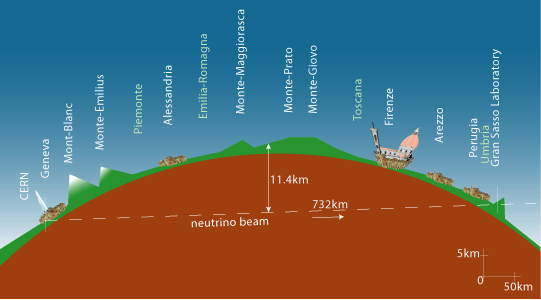Related links
- Press release 2006: CERN switches on neutrino beam to Gran Sasso
- Spotlight: Neutrinos, get set, go!
- CNGS website
- OPERA experiment website
- ICARUS experiment website
- Gran Sasso laboratory website
This website is no longer maintained. Its content may be obsolete. Please visit http://home.cern for current CERN information.
The CERN Neutrinos to Gran Sasso project aims to unravel some of the mysteries surrounding neutrinos - very light, neutral particles that interact very little with matter. Three types - or flavours - of neutrino exist: the electron neutrino, the muon neutrino and the tau neutrino. But it seems that neutrinos are the chameleons of the particle world: they can change from one flavour into another. This phenomenon, called ‘oscillation’, occurs as the neutrinos travel long distances through matter. It is important to investigate it further as it is directly related to the tiny mass of the neutrinos.

The CNGS project sends muon neutrinos from CERN to the Gran Sasso National Laboratory (LNGS), 732 km away in Italy. There, two experiments, OPERA and ICARUS, wait to find out if any of the muon neutrinos have transformed into tau neutrinos. To create the neutrino beam, a proton beam from the Super Proton Synchrotron at CERN is directed onto a graphite target, creating particles called pions and kaons. These particles are fed into a system of two magnetic lenses that focus the particles into a parallel beam in the direction of Gran Sasso. Next, in a 1 km long tunnel, the pions and kaons decay into muons and muon neutrinos. At the end of this decay tunnel, an 18 m thick block of graphite and metal absorbs the remaining protons, and pions and kaons that did not decay. The muons are stopped by the rock beyond. Only, the muon neutrinos remain to streak through the rock on their journey to Italy.